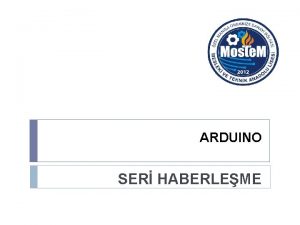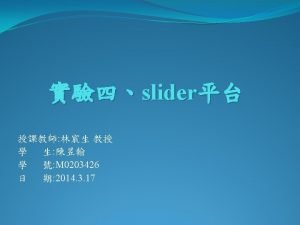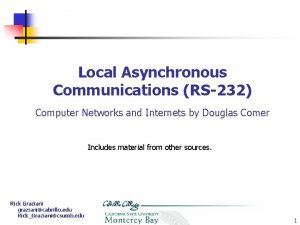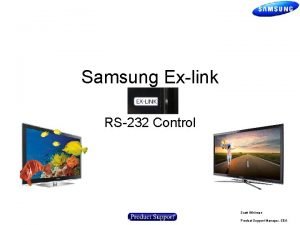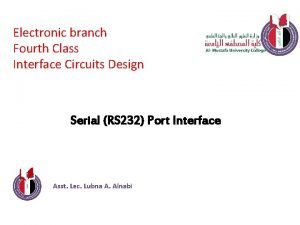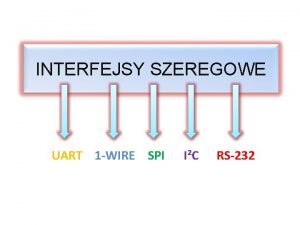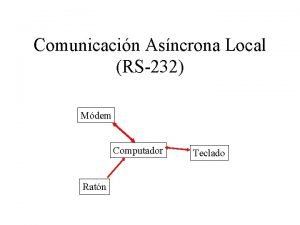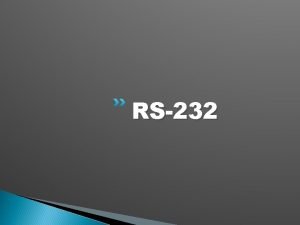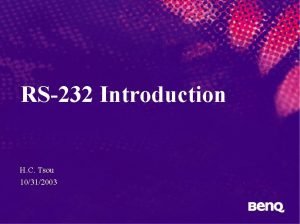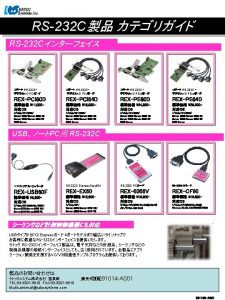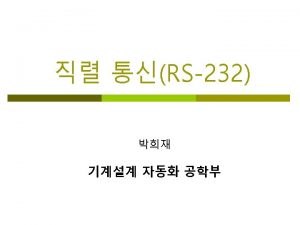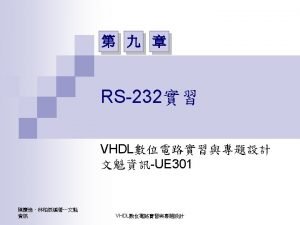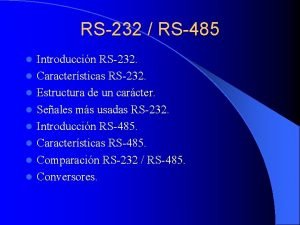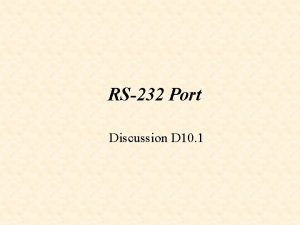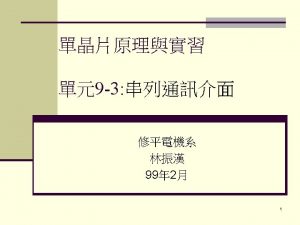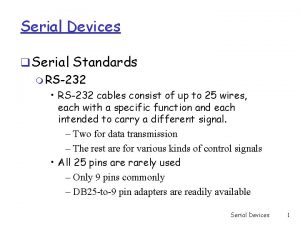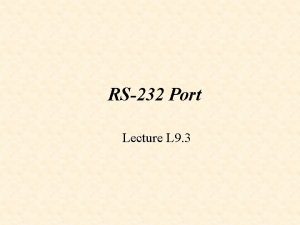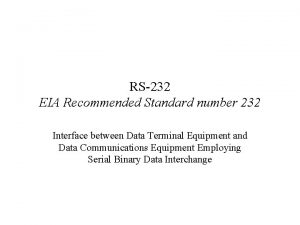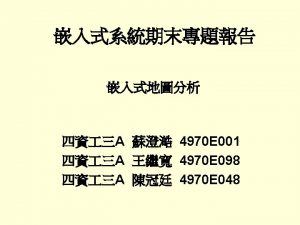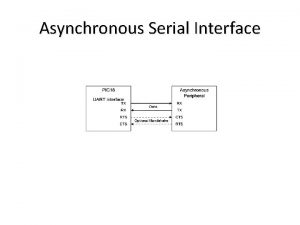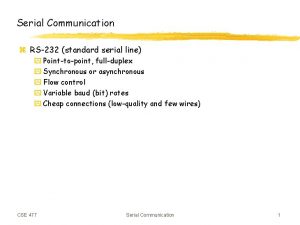RS232 C Standard The RS232 C standard is



















- Slides: 19


RS-232 C Standard • The RS-232 C standard is an asynchronous serial communication method. • Serial means that the information is sent 1 -bit at a time. • Asynchronous means that the information isn't sent at predefined time slots (like with a fixed clock, for instance). See http: //en. wikipedia. org/wiki/Asynchronous_serial_communication • The RS-232 C standard works at the physical layer of the communication standard. This is the lowest level and the one that physically connects the devices. • The communication is done through the serial port of the PC. This is a male connector with 25 (old) or 9 (new) pins, in both cases only 9 pins, at the most, are used. 2

Why Use a Serial Interface? • Good question? We program in parallel (writing a value to a char, int, float), why communicate serially? Less data is transferred per send. • There are several reasons: – Serial cables can be longer than parallel cables. – Serial cables are cheaper than parallel cables, although there is a cost of converting parallel data to the serial connection. – Infra Red are serial. Detecting 1 point of light isn't easy, try detecting 8 or more points of light. – Many microcontrollers ( ( מעבדים - מיקרו use SCI (Serial Communication Interface) to communicate with the outer world. – SATA disks are serial. See http: //en. wikipedia. org/wiki/Serial_ATA 3

The Connector The pins abbreviations are (numbers in parentheses are the 25 D pin numbers. 1. CD (8) 2. RD (Rx) (3) 3. TD (Tx) (2) 4. DTR (20) 5. SG (Ground) (7) 6. DSR (6) 7. RTS (4) 8. CTS (5) 9. RI (22) 4

9 D to 25 D Conversion 5

DTE and DCE • A DTE (Data Terminal Device) is usually a computer. • A DCE (Data Communication Device) is usually a Modem. A Cable connecting 2 PCs is also a Modem. It is called a NULL Modem. • The problem with communications is that the DTE speed is much greater than the DCE speed. The communication protocol bridges this gap (. ( מגשר על הפער • The DCE to DCE speed is also called the line speed. • Maximum Modem speed today is 56 K BPS (56 K Bits Per Second), this is the line speed. On the other hand the maximum DTE/DCE speed is 115, 200 BPS. This is the gap software must bridge. 6

The UART 8250 • OK, lets say we understood the previous slides. How does the CPU send signals through the serial port? • A UART (Universal Asynchronous Receiver/Transmitter) is used. The UART is a device that the CPU programs to perform tasks for it. • In our case the UART 8250 is the device that controls the serial port. The 8250 is the first of a family that contains the 8250 B, 16450, 16550 and others. • The 8250 was introduced with the XT PC, so your computer probably has a later version. But all are backward compatible, so we can program as though we have a 8250. 7

Programming the UART 8250 • Programming is done by reading and writing registers of the 8250. The registers are: Base Address +0 (DLAB=0) +0 (DLAB=1) +1 (DLAB=0) +1 (DLAB=1) +2 +2 +3 +4 +5 +6 +7 Mode Write Read Rd/Wr Read Write Rd/Wr Read Rd/Wr Name Transmitter Holding Buffer Receiver Buffer Divisor Latch Low Byte Interrupt Enable Register Divisor Latch High Byte Interrupt Idendification Register FIFO Control Register Line Control Register Modem Control Register Line Status Register Modem Status Register Scratch Register THR RBR DLL IER DLM IIR FCR LCR MCR LSR MSR SCR 8

Accessing the Registers • On the 80 x 86 architecture I/O devices are accessed using special I/O instructions. These instructions are called IN and OUT, access I/O Ports. • I/O Ports are addresses in what's called I/O space, these are addresses that when accessed using the special I/O instructions access the registers of I/O devices. • The PC has standard ports for the serial interfaces, these ports are called COM 1 - COM 4. They are mapped to the following port numbers and IRQ (Interrupt Request) lines. Name Port address IRQ COM 1 3 F 8 4 COM 2 2 F 8 3 (usually the serial mouse) COM 3 3 E 8 4 COM 4 2 F 8 3 9

Getting the Port Addresses #include <stdio. h> #include <dos. h> void main(void) { unsigned int far *ptraddr; /* Pointer to location of Port Addresses */ unsigned int address, a; /* Address of Port */ ptraddr=(unsigned int far *)0 x 00000400; for (a = 0; a < 4; a++) { address = *ptraddr; if (address == 0) printf("No port found for COM%d n", a+1); else printf("Address assigned to COM%d is %Xhn", a+1, address); *ptraddr++; }} 10

Accessing the Registers • The port addresses for the COMs are defined in the BIOS (Basic I/O System) ROM (Read Only Memory) from addresses 0 x 400 to 0 x 408. • OK. So how do we access the registers? • There is a C interface to the IN and OUT instructions: int inp(unsigned short port); // read a byte from the port int outp(unsigned short port, int val); // write a byte to the port • Using these two instruction is is possible to access the registers defined in the previous slides. For instance to read the LCR we have to write: int val; val = inp(0 x 3 F 8 + 3); // or inp(0 x 3 FB); • Look at the functions descriptions in the help manuals of Visual 11 C++ or Borland. C.

Real vs. Protected Mode • Protected mode is the mode that the computer runs in when it has to support multiple users. UNIX and XP run only in protected mode. A regular user can’t access the I/O ports. • Real mode (or single-user mode, or priveleged-mode) is the mode used by the OS to access I/O devices. DOS runs in real mode. So we will use a Virtual PC to run DOS in order to run our programs. • inp and outp work when compiled with Borland. C, the Visual C++ versions (_inp and _outp) might create problems, try it out. 12

Baud Rate • The rate of transfer is in BPS. The UART 8250 has a clock that's rate is 1. 8432 MHz. The UART divides the clock signal by 16, giving a maximum baud of 115, 200 BPS. • But this rate might be too fast for some devices, so the rate is controllable. • Lets say we want to communicate at 2400 BPS. We have to divide the clock rate by a number multiplied by 16 to get the desired rate. This number is called the baud rate. • Thus, in our case 2400 = 1. 8432*106/(baud rate * 16). • The baud rate = 1. 8432*106/(2400 * 16) = 48 • The baud rate is stored in the DLL and DLM before transmission starts. The DLL Contains the 8 LSBs (Least Significant Bits) and the DLM contains the 8 MSBs (Most Significant Bits). 13

RS-232 C Waves • So far we have introduced RS-232 Communications in relation to the PC. RS-232 communication is asynchronous. That is a clock signal is not sent with the data. Each word is synchronized using its start bit, and an internal clock on each side (defined by the baud rate) reads the data. • The signal is in the logical 1 state (also called "mark"), a start bit which is in logical state 0 (also called "space") signals that data is about to be sent. Then 8 bits of data are sent (this can be changed), a parity bit is optional (not shown here) and the a stop bit (or bits) is sent. This is called a frame (. ( מסגרת The data is framed between a stop and start bit. • The above waveform is relevant to the TD and RD lines only. 14

The Line Control Register (LCR) • The LCR is a 8 -bit register (as all 8250 registers) that controls the data that goes on the TD and RD lines. Its bits are: • Bits 0, 1: Select the word length, from 5 to 8 bits. – – 00: 5 bit word 01: 6 bit word 10: 7 bit word 11: 8 bit word • Bit 2: Sets the length of the stop bit. – 0: 1 bit length – 1: 1. 5 bit length if 5 bit word selected, 2 bit length if 6, 7, 8 bit word selected • Bit 6: Sets the break control bit. When this bit is set to 1 the TD line is permanently set to 0 (space). • Bit 7: Sets the DLAB (Divisor Latch Access Bit). – 0: enables access to RBR, THR, and IER. – 1: enables access to DLL and DLM (to set the baud). 15

The LCR Parity Bits • Bit 3: Parity enable bit. – 0: no parity bit sent – 1: parity bit sent • Bit 4: Chooses between odd and even parity. – 0: odd parity. The number of '1's in the word is counted. If odd, the parity bit is set, if even, it isn't set. – 1: even parity. The number of '1's in the word is counted. If even, the parity bit is set, if odd it isn't set. – For instance the word 11001011 has odd parity. So if parity is enabled (bit 3) and bit 4 is 0 (odd parity), the parity bit sent will be 1 and the receiver will check the data and expect to find a 1 in the parity bit. • Bit 5: Sets the "sticky" parity bit. The parity bit is always the same value, "high" (1) or "low" (0). – 0: The parity bit is set by the input word. – 1: The parity bit is 0 if bit 4 is 1, the parity bit is 1 if bit 4 is 0. This setting is permanent as long as bit 6 is set. 16

Sending a Word • In order to send a word the following steps must be taken on both sides (sender and receiver). • • • Set the baud rate by computing it and loading DLL and DLM. Set the parity (enabled on/off, odd/even). Set the word length (5 -8 bits). Set the number of stop bits. Write a word to the THR. This word (lets assume 8 -bit words) is written into the TSR (Transmit Shift Register). The TSR then shifts the bits out one by one and transmits them on the TD line. THR TSR TD • The word is received by the RD on the receivers side and stored in the RBR register. 17

The Line Status Register (LSR) • The LSR shows the current status of communication, errors in transmission will be written into the register. • Bit 0: Data Ready (DR) indicator. When set, it indicates that a byte is ready to be read from the RBR. Reading from the RBR sets the DR bit to 0. • Bit 1: Overrun Error (OE) indicator. When set indicates that a new byte has been received before the current byte in the RBR has been read. The OE is reset (set to 0) when the LSR is read. • Bit 2: Parity Error (PE) indicator. When set indicates that a parity error has occurred. Is reset by reading the LSR. • Bit 3: Framing Error (FE) indicator. Is set whenever the received word doesn't have a valid stop bit. The stop bit following the last data bit or parity is detected as a 0 instead of a 1. • Bit 4: Break Interrupt (BI) indicator. Is set whenever the RD line 18 is held in the space state for longer than it takes to send a word.

The LSR (cont. ) • Bit 5: Transmitter Holding Register Empty (THRE) indicator. When set it is possible to write another byte into the THR. The bit is set when the byte is transferred from the THR to the TSR. The bit is reset when the processor starts loading a byte into the THR. • Bit 6: Transmitter Shift Register Empty (THRE) indicator. When set, indicates that the TSR is empty. It is reset when a word is loaded into it from the THR. • Bit 7: Unused. Permanent 0. 19
 Arduino rs232 haberleşme
Arduino rs232 haberleşme Rs232 adalah
Rs232 adalah Rs232 voltage levels
Rs232 voltage levels Ex-link port
Ex-link port Rs232 data format
Rs232 data format Spi rs232
Spi rs232 Trame rs232
Trame rs232 Bautrate
Bautrate Benq rs232
Benq rs232 Phản ứng thế ankan
Phản ứng thế ankan Các môn thể thao bắt đầu bằng tiếng nhảy
Các môn thể thao bắt đầu bằng tiếng nhảy Khi nào hổ con có thể sống độc lập
Khi nào hổ con có thể sống độc lập Thiếu nhi thế giới liên hoan
Thiếu nhi thế giới liên hoan điện thế nghỉ
điện thế nghỉ Một số thể thơ truyền thống
Một số thể thơ truyền thống Thế nào là sự mỏi cơ
Thế nào là sự mỏi cơ Trời xanh đây là của chúng ta thể thơ
Trời xanh đây là của chúng ta thể thơ Số nguyên tố là
Số nguyên tố là Tỉ lệ cơ thể trẻ em
Tỉ lệ cơ thể trẻ em Phối cảnh
Phối cảnh
